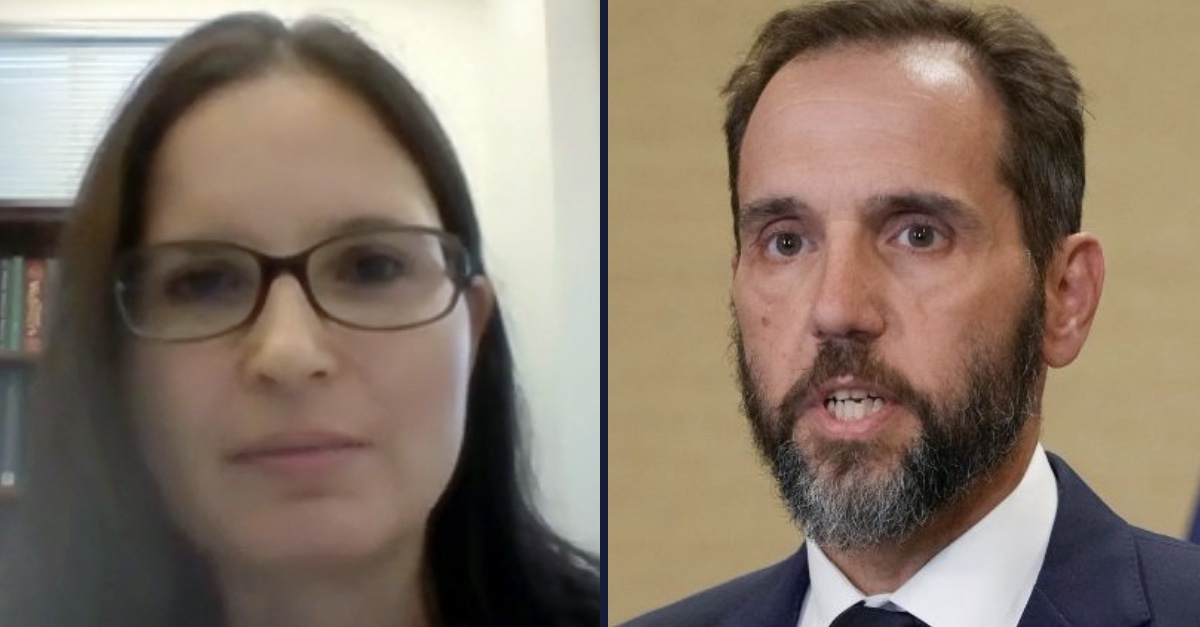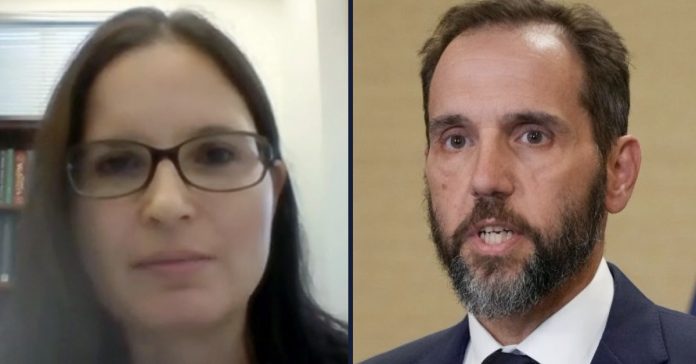
Judge Aileen Cannon (left) during a Senate Judiciary Committee oversight nomination hearing on July 29, 2020 (U.S. Senate via AP), Special counsel Jack Smith (right) speaks about an indictment of former President Donald Trump, Aug. 1, 2023, at a Department of Justice office in Washington. (AP Photo/Jacquelyn Martin)
The federal judge presiding over Jack Smith’s Mar-a-Lago classified documents prosecution of Donald Trump issued an order favorable to the former president’s co-defendants at the expense of the special counsel — all while misidentifying the office she slammed.
U.S. District Judge Aileen Cannon, in multiple ways, said that Smith’s attempt to use the Classified Information Procedures Act or CIPA to “restrict” Trump valet Walt Nauta and Mar-a-Lago property manager Carlos De Oliveira “almost entirely from reviewing classified discovery to be produced in the case” — “placing the burden to justify otherwise on defense counsel” — is not what Section 3 of the statute is designed to do.
Judge Cannon, a Trump appointee whose special master rulings made waves at the start of the case but were overturned by conservative appellate judges, noted that her ruling “primarily” dealt with the “OSC’s proposed protective orders as to Defendants Nauta and De Oliveira,” as the protective order for Trump and his lawyers “was entered without objection except as to a conferral-location issue on which the Court overruled Defendant Trump’s objection.”
Notably, throughout the order the judge erroneously identified the prosecution as the Office of Special Counsel, an entirely different government entity that uses the acronym OSC, when the reference should be to the Special Counsel’s Office or SCO, which is the acronym Smith’s office has used in its own filings before Cannon.
The judge, writing that the “protective orders are not brought pursuant to any other section of CIPA,” began the ruling by pointing out that Section 3 says, “Upon motion of the United States, the court shall issue an order to protect against the disclosure of any classified information disclosed by the United States to any defendant in any criminal case in a district court of the United States.”
Cannon’s quibble with Smith’s team was the argument, as the judge put it, that the “term ‘defendant’ in Section 3 means, essentially, defense counsel to the exclusion of defendant.”
“In the OSC’s view, even though Section 3 refers to ‘defendant’ — and even though Congress elsewhere in CIPA specifically referred to ‘any attorney of the defendant’ as distinct from ‘the defendant,’ see CIPA § 2 — the Court nevertheless must read the term ‘the defendant’ in Section 3 to mean ‘attorney for the defendant’ and then simultaneously interpret Section 3 to exclude ‘the defendant’ facing criminal indictment, at least in cases where the government proffers a basis to object to such disclosure pretrial,” the judge wrote.
Cannon called this a “broad and atextual interpretation” which “really amounts to an expedient reading of Section 3 that is at odds with its plain meaning.”
If Jack Smith wants to “make the required showing to authorize deletion or substitution of discoverable classified information, or parts thereof, from Defendants,” the judge said, he can do so pursuant to Section 4 of CIPA, which says [emphases ours]:
The court, upon a sufficient showing, may authorize the United States to delete specified items of classified information from documents to be made available to the defendant through discovery under the Federal Rules of Criminal Procedure, to substitute a summary of the information for such classified documents, or to substitute a statement admitting relevant facts that the classified information would tend to prove. The court may permit the United States to make a request for such authorization in the form of a written statement to be inspected by the court alone. If the court enters an order granting relief following such an ex parte showing, the entire text of the statement of the United States shall be sealed and preserved in the records of the court to be made available to the appellate court in the event of an appeal.
Styling Smith’s proposal as an end-run “around the plain meaning of Section 3 and the surrounding sections,” the judge said the special counsel’s “almost blithe” arguments “lack merit.”
“[W]hat the OSC advances here, in almost blithe terms, is that it can satisfy its discovery obligations by giving discovery to the agent-attorney and then banning that attorney (on penalty of criminal prosecution) from sharing any of it with his principal, the defendant,” the order continued. “This broad theory is not consistent with agency principles or with Rule 16, Brady, or the Jencks Act.”
Cannon then blasted the authorities Smith cited to bolster his arguments as “a handful of non-binding examples,” pillorying the special counsel’s attempt “to explain away the clear distinction in Section 2, which as noted, uses the term ‘any attorney of the defendant’ in the same line alongside a reference to ‘defendant.””
“This argument creates the impression of plausibility but is unpersuasive,” the judge wrote.
The judge declined to accept Smith’s reading on textualist grounds.
“In the end, whatever the contours of the OSC’s broad theory prohibiting a defendant’s access to discoverable information, the answer is not to change the natural meaning of a statutory word in Section 3 but rather to use the mechanism provided in CIPA to handle matters related to restricting discovery, which in the case of CIPA is Section 4,” Cannon summed up.
After calling Jack Smith’s arguments “broad and atextual,” “almost blithe,” an explaining away, seemingly plausible but not actually persuasive, an attempt to minimize, and a meritless attempted end-run around the “plain meaning of Section 3” buttressed by “a handful of non-binding examples,” Judge Cannon wrote that “[n]othing in this Order shall be construed to minimize the importance of protecting and avoiding disclosure of classified information in this case or in any case.”
“To the contrary, the protective orders already entered implement that purpose through a variety of security procedures. All the Court determines in this Order is that Section 3 is not the means by which the OSC can seek to shield discoverable information from the criminal defendants in this case,” the judge concluded. “And again, nothing herein authorizes the disclosure of any classified information to any Defendant beyond the terms of the existing protective orders.”
Read the order here.
Have a tip we should know? [email protected]

